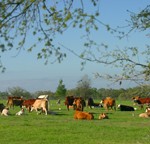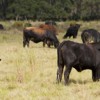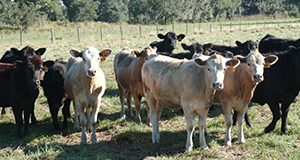This new 6-page document explains methods to measure forage mass and utilize that information to estimate an adequate stocking rate. Written by Jose Dubeux, Marcelo Wallau, João Vendramini, Liliane Silva, Jane Griffin, Nicolas DiLorenzo, and Erick Santos, and published by the UF/IFAS Agronomy Department, June 2019.
http://edis.ifas.ufl.edu/ag434
Tag: Nicolas DiLorenzo
Antibiotic Use and Resistance for Beef Cattle Producers
Antibiotic-resistant microorganisms cause millions of illnesses and cost billions of dollars in the United States each year. This 5-page fact sheet written by Chad Carr, Matt Hersom, K. C. Jeong, Nicolas DiLorenzo, Jason Scheffler, Victoria Roberts, Gina Faniola, Stephanie Miller, Haley Denney, Nahilia Williams, and Bianca McCracken and published by the UF/IFAS Department of Animal Sciences discusses the use of antibiotics in cattle production operations and answers some common questions about antibiotics and antibiotic-resistant microorganisms.
http://edis.ifas.ufl.edu/an351
Forage-Based Heifer Development Program for North Florida
Developing replacement heifers to become productive females in the cow herd is a tremendous investment in a cow-calf operation that takes several years to make a return. Fortunately, there are several options to develop heifers on forage-based programs that can help reduce costs while meeting required industry performance targets. This new 4-page document proposes a model for replacement heifer development based on forage research trials at the UF/IFAS North Florida Research and Education Center (UF/IFAS NFREC) in Marianna, FL. Written by Jose Dubeux, Nicolas DiLorenzo, Kalyn Waters, and Jane C. Griffin, and published by the UF/IFAS Agronomy Department, October 2018.
http://edis.ifas.ufl.edu/ag424
The Florida Bull Test 2016-2017
The 17th annual Florida Bull Test Sale was held on January 21, 2017 at the conclusion of the 2016-2017 Florida Bull Test. The test evaluated the performance potential and breeding soundness of bulls consigned to the program at the UF/IFAS North Florida Research and Education Center (NFREC). This new 9-page fact sheet discusses test procedures, assessment of feed efficiency, test rules and regulations, health requirements, and test results. Written by Luara B. Canal, G. Cliff Lamb, and Nicolas DiLorenzo, and published by the UF/IFAS Department of Animal Sciences, February 2018.
http://edis.ifas.ufl.edu/an341
The Florida Bull Test 2015-2016
The 16th annual Florida Bull Test Sale was held on January 16, 2016 at the conclusion of the 2015–2016 Florida Bull Test. The test evaluated the performance potential and breeding soundness of bulls consigned to the program at the UF/IFAS North Florida Research and Education Center (NFREC). This 10-page fact sheet covers the test procedures, assessment of feed efficiency, general policies and procedures, health requirements, test results, and sale summary. Written by Carla D. Sanford, G. Cliff Lamb, and Nicolas DiLorenzo, and published by the UF Department of Animal Sciences, November 2016.
http://edis.ifas.ufl.edu/an328
The Florida Bull Test 2014/2015
The 2014-2015 Florida Bull Test concluded with the evaluation of 103 bulls. The test assessed the performance potential and breeding soundness of bulls consigned to the program at the UF/IFAS North Florida Research and Education Center (NFREC). This 9-page fact sheet covers the test procedures, feed efficiency assessment, test rules and regulations, health requirements, test results, and sale summary. Written by Carla D. Sanford, G. Cliff Lamb, and Nicolas DiLorenzo, and published by the UF Department of Animal Sciences, June 2016.
http://edis.ifas.ufl.edu/an325
Environmental Impact of Beef Cattle Production Systems
 This 6-page fact sheet discusses beef demand in the context of a growing population, beef production’s greenhouse gases and their effect on the environment, the great advantage of ruminants, generating accurate greenhouse gas emissions estimates, greenhouse gas emissions by economic sector, and mitigation strategies. Written by Nicolas DiLorenzo, G. Cliff Lamb, Jose Dubeux, John Arthington, Joao Vendramini, and Phillip Lancaster and published by the UF/IFAS Department of Animal Sciences, November 2014. (UF/IFAS Photo by Thomas Wright)
This 6-page fact sheet discusses beef demand in the context of a growing population, beef production’s greenhouse gases and their effect on the environment, the great advantage of ruminants, generating accurate greenhouse gas emissions estimates, greenhouse gas emissions by economic sector, and mitigation strategies. Written by Nicolas DiLorenzo, G. Cliff Lamb, Jose Dubeux, John Arthington, Joao Vendramini, and Phillip Lancaster and published by the UF/IFAS Department of Animal Sciences, November 2014. (UF/IFAS Photo by Thomas Wright)
http://edis.ifas.ufl.edu/an302
Potential Bull Buyers Perceive Increased Value to their Operations When Purchasing Bulls from the Florida Bull Test
 Since its beginning in 2000, the Florida Bull Test has been under constant evolution to achieve its goal of helping producers select high-quality sires, thereby improving production and profitability of beef cattle producers in Florida and the Southeast United States. A survey of potential buyers before the 2014 sale succeeded in identifying which characteristics of bulls are most important to buyers purchasing bulls: purchasing bulls from the Florida Bull Test increases the value of calves sired by improving performance, genetics, and feed efficiency of their herds. This 3-page fact sheet was written by Vitor R. G. Mercadante, Darren D. Henry, Francine M. Ciriaco, Paula M. Mercadante, Tessa Schulmeister, Nicolas DiLorenzo, and G. Cliff Lamb, and published by the UF Department of Animal Sciences, November 2014.
Since its beginning in 2000, the Florida Bull Test has been under constant evolution to achieve its goal of helping producers select high-quality sires, thereby improving production and profitability of beef cattle producers in Florida and the Southeast United States. A survey of potential buyers before the 2014 sale succeeded in identifying which characteristics of bulls are most important to buyers purchasing bulls: purchasing bulls from the Florida Bull Test increases the value of calves sired by improving performance, genetics, and feed efficiency of their herds. This 3-page fact sheet was written by Vitor R. G. Mercadante, Darren D. Henry, Francine M. Ciriaco, Paula M. Mercadante, Tessa Schulmeister, Nicolas DiLorenzo, and G. Cliff Lamb, and published by the UF Department of Animal Sciences, November 2014.
http://edis.ifas.ufl.edu/an313
The Florida Bull Test, 2013-2014
 The 2013-2014 Florida Bull Test was a 112-day performance test and a breeding soundness evaluation of each bull that qualified for the auction. Table 1 summarizes feed efficiency data; Table 2 individual feed intake and feed efficiency; and Table 3 individual animal performance. This 10-page fact sheet was written by Vitor R. G. Mercadante, G. Cliff Lamb, and Nicolas DiLorenzo, and published by the UF Department of Animal Sciences, May 2014.
The 2013-2014 Florida Bull Test was a 112-day performance test and a breeding soundness evaluation of each bull that qualified for the auction. Table 1 summarizes feed efficiency data; Table 2 individual feed intake and feed efficiency; and Table 3 individual animal performance. This 10-page fact sheet was written by Vitor R. G. Mercadante, G. Cliff Lamb, and Nicolas DiLorenzo, and published by the UF Department of Animal Sciences, May 2014.
http://edis.ifas.ufl.edu/an301
The Florida Bull Test 2012-2013
 The North Florida Research and Education Center in Marianna, Florida annually hosts the Florida Bull Test. By controlling the environmental factors and taking Expected Progeny Differences (EPD’s) into account, the data clearly emphasizes the dual importance of genetics and environment in all cattle types. This 9-page fact sheet presents the procedures, rules, and results of the 2012-2013 test. Written by G. Cliff Lamb and Nicolas DiLorenzo, and published by the UF Department of Animal Sciences, October 2013.
The North Florida Research and Education Center in Marianna, Florida annually hosts the Florida Bull Test. By controlling the environmental factors and taking Expected Progeny Differences (EPD’s) into account, the data clearly emphasizes the dual importance of genetics and environment in all cattle types. This 9-page fact sheet presents the procedures, rules, and results of the 2012-2013 test. Written by G. Cliff Lamb and Nicolas DiLorenzo, and published by the UF Department of Animal Sciences, October 2013.
http://edis.ifas.ufl.edu/an290
Understanding the Effects of Forage Composition and Structure in Ruminant Nutrition (AN288)
 Approximately 68% of the 16 million square miles of agricultural land worldwide is used for permanent pastures for livestock production. Fortunately, ruminants can convert plant matter that is inedible or of low nutritional value for monogastrics (i.e., swine or poultry) into calorically dense products of high nutritional value. However, the process of converting poor quality plant matter into useful nutrients for ruminants is complex. This 3-page fact sheet provides an overview and understanding of how forage composition and structure affect the nutritive value and nutrient availability to ruminants. Written by Kalyn M. Waters, Nicolas DiLorenzo, and G. Cliff Lamb, and published by the UF Department of Animal Sciences, March 2013.
Approximately 68% of the 16 million square miles of agricultural land worldwide is used for permanent pastures for livestock production. Fortunately, ruminants can convert plant matter that is inedible or of low nutritional value for monogastrics (i.e., swine or poultry) into calorically dense products of high nutritional value. However, the process of converting poor quality plant matter into useful nutrients for ruminants is complex. This 3-page fact sheet provides an overview and understanding of how forage composition and structure affect the nutritive value and nutrient availability to ruminants. Written by Kalyn M. Waters, Nicolas DiLorenzo, and G. Cliff Lamb, and published by the UF Department of Animal Sciences, March 2013.
http://edis.ifas.ufl.edu/an288
The Florida Bull Test 2011-2012 (AN284)
 The North Florida Research and Education Center in Marianna, Florida annually hosts the Florida Bull Test. By controlling the environmental factors and taking Expected Progeny Differences (EPD’s) into account, the data clearly emphasizes the dual importance of genetics and environment in all cattle types. This 5-page fact sheet presents the procedures, rules, and results of the 2011-2012 test. Written by G. Cliff Lamb and Nicolas DiLorenzo, and published by the UF Department of Animal Sciences, December 2012.
The North Florida Research and Education Center in Marianna, Florida annually hosts the Florida Bull Test. By controlling the environmental factors and taking Expected Progeny Differences (EPD’s) into account, the data clearly emphasizes the dual importance of genetics and environment in all cattle types. This 5-page fact sheet presents the procedures, rules, and results of the 2011-2012 test. Written by G. Cliff Lamb and Nicolas DiLorenzo, and published by the UF Department of Animal Sciences, December 2012.
http://edis.ifas.ufl.edu/an284
The Florida Bull Test 2010-2011 (AN273)
 The North Florida Research and Education Center in Marianna, Florida annually hosts the Florida Bull Test. By controlling environmental factors and taking Expected Progeny Differences (EPD’s) into account, the data emphasizes the dual importance of genetics and environment in all cattle types. Beef cattle producers can use this information to select superior cattle for the best possible herd. This 5-page fact sheet provides the results of the 2010-11 Florida bull test. Written by G. Cliff Lamb and Nicolas DiLorenzo, and published by the UF Department of Animal Science, November 2011. (UF/IFAS photo by Thomas Wright)
The North Florida Research and Education Center in Marianna, Florida annually hosts the Florida Bull Test. By controlling environmental factors and taking Expected Progeny Differences (EPD’s) into account, the data emphasizes the dual importance of genetics and environment in all cattle types. Beef cattle producers can use this information to select superior cattle for the best possible herd. This 5-page fact sheet provides the results of the 2010-11 Florida bull test. Written by G. Cliff Lamb and Nicolas DiLorenzo, and published by the UF Department of Animal Science, November 2011. (UF/IFAS photo by Thomas Wright)
http://edis.ifas.ufl.edu/an273




